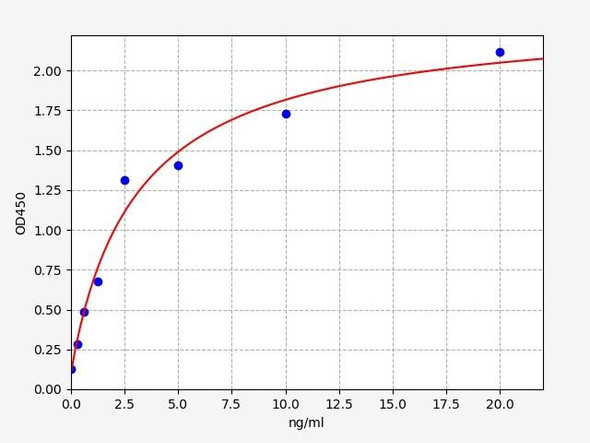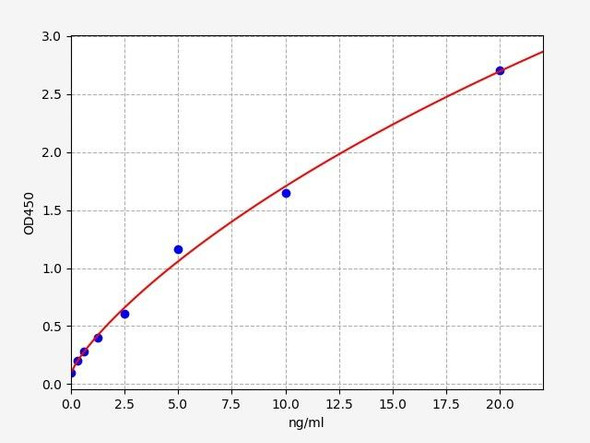Description
Human Potassium voltage-gated channel subfamily B member 2 (KCNB2) ELISA Kit
The Human Potassium Voltage-Gated Channel Subfamily B Member 2 (KCNB2) ELISA Kit is a powerful tool for the precise measurement of KCNB2 levels in human samples including serum, plasma, and cell culture supernatants. This kit is renowned for its exceptional sensitivity and specificity, delivering accurate and consistent results for a variety of research purposes.KCNB2 is a key player in regulating potassium ion channels, which are crucial for controlling membrane potential and nerve signal transmission. Dysregulation of KCNB2 has been linked to various neurological disorders, making it a valuable biomarker for studying these conditions and potentially developing therapeutic interventions.
With the Human KCNB2 ELISA Kit, researchers can confidently analyze KCNB2 levels in human samples, gaining valuable insights into the role of this protein in health and disease. Trust in this kit for dependable and reproducible results that further your understanding of potassium channel function and its implications in human physiology.
| Product Name: | Human Potassium voltage-gated channel subfamily B member 2 (KCNB2) ELISA Kit |
| SKU: | HUEB2344 |
| Size: | 96T |
| Target: | Human Potassium voltage-gated channel subfamily B member 2 (KCNB2) |
| Synonyms: | Voltage-gated potassium channel subunit Kv2.2 |
| Assay Type: | Competitive |
| Detection Method: | ELISA |
| Reactivity: | Human |
| Detection Range: | 0.312-20ng/mL |
| Sensitivity: | 0.13ng/mL |
| Intra CV: | 4.6% | ||||||||||||||||||||
| Inter CV: | 8.0% | ||||||||||||||||||||
| Linearity: |
| ||||||||||||||||||||
| Recovery: |
| ||||||||||||||||||||
| Function: | Voltage-gated potassium channel that mediates transmembrane potassium transport in excitable membranes, primarily in the brain and smooth muscle cells. Channels open or close in response to the voltage difference across the membrane, letting potassium ions pass in accordance with their electrochemical gradient. Homotetrameric channels mediate a delayed-rectifier voltage-dependent outward potassium current that display rapid activation and slow inactivation in response to membrane depolarization. Can form functional homotetrameric and heterotetrameric channels that contain variable proportions of KCNB1; channel properties depend on the type of alpha subunits that are part of the channel. Can also form functional heterotetrameric channels with other alpha subunits that are non-conducting when expressed alone, such as KCNS1 and KCNS2, creating a functionally diverse range of channel complexes. In vivo, membranes probably contain a mixture of heteromeric potassium channel complexes, making it difficult to assign currents observed in intact tissues to any particular potassium channel family member. Contributes to the delayed-rectifier voltage-gated potassium current in cortical pyramidal neurons and smooth muscle cells. |
| Uniprot: | Q92953 |
| Sample Type: | Serum, plasma, tissue homogenates, cell culture supernates and other biological fluids |
| Specificity: | Natural and recombinant human Potassium voltage-gated channel subfamily B member 2 |
| Sub Unit: | Homotetramer or heterotetramer with KCNB1. Heterotetramer with KCNS1 and KCNS2. |
| Subcellular Location: | Cell membrane Multi-pass membrane protein Perikaryon Cell projection Dendrite Localized uniformly throughout cell bodies and dendrites. Colocalizes with KCNB1 to high-density somatodendritic clusters on cortical pyramidal neurons. |
| Storage: | Please see kit components below for exact storage details |
| Note: | For research use only |
| UniProt Protein Function: | Kv2.2: Mediates the voltage-dependent potassium ion permeability of excitable membranes. Channels open or close in response to the voltage difference across the membrane, letting potassium ions pass in accordance with their electrochemical gradient. Belongs to the potassium channel family. B (Shab) (TC 1.A.1.2) subfamily. Kv2.2/KCNB2 sub-subfamily. |
| UniProt Protein Details: | Protein type:Membrane protein, multi-pass; Channel, potassium; Membrane protein, integral Chromosomal Location of Human Ortholog: 8q13.2 Cellular Component: dendrite; plasma membrane; voltage-gated potassium channel complex Molecular Function:delayed rectifier potassium channel activity; protein heterodimerization activity Biological Process: potassium ion transport; regulation of smooth muscle contraction |
| NCBI Summary: | Voltage-gated potassium (Kv) channels represent the most complex class of voltage-gated ion channels from both functional and structural standpoints. Their diverse functions include regulating neurotransmitter release, heart rate, insulin secretion, neuronal excitability, epithelial electrolyte transport, smooth muscle contraction, and cell volume. Four sequence-related potassium channel genes - shaker, shaw, shab, and shal - have been identified in Drosophila, and each has been shown to have human homolog(s). This gene encodes a member of the potassium channel, voltage-gated, shab-related subfamily. This member is a delayed rectifier potassium channel. The gene is expressed in gastrointestinal smooth muscle cells. [provided by RefSeq, Jul 2008] |
| UniProt Code: | Q92953 |
| NCBI GenInfo Identifier: | 24418855 |
| NCBI Gene ID: | 9312 |
| NCBI Accession: | Q92953.2 |
| UniProt Secondary Accession: | Q92953,Q7Z7D0, Q9BXD3, |
| UniProt Related Accession: | Q92953 |
| Molecular Weight: | 102,563 Da |
| NCBI Full Name: | Potassium voltage-gated channel subfamily B member 2 |
| NCBI Synonym Full Names: | potassium voltage-gated channel subfamily B member 2 |
| NCBI Official Symbol: | KCNB2 |
| NCBI Official Synonym Symbols: | KV2.2 |
| NCBI Protein Information: | potassium voltage-gated channel subfamily B member 2 |
| UniProt Protein Name: | Potassium voltage-gated channel subfamily B member 2 |
| UniProt Synonym Protein Names: | Voltage-gated potassium channel subunit Kv2.2 |
| Protein Family: | Potassium voltage-gated channel subfamily |
| UniProt Gene Name: | KCNB2 |
| UniProt Entry Name: | KCNB2_HUMAN |
| Component | Quantity (96 Assays) | Storage |
| ELISA Microplate (Dismountable) | 8×12 strips | -20°C |
| Lyophilized Standard | 2 | -20°C |
| Sample Diluent | 20ml | -20°C |
| Assay Diluent A | 10mL | -20°C |
| Assay Diluent B | 10mL | -20°C |
| Detection Reagent A | 120µL | -20°C |
| Detection Reagent B | 120µL | -20°C |
| Wash Buffer | 30mL | 4°C |
| Substrate | 10mL | 4°C |
| Stop Solution | 10mL | 4°C |
| Plate Sealer | 5 | - |
Other materials and equipment required:
- Microplate reader with 450 nm wavelength filter
- Multichannel Pipette, Pipette, microcentrifuge tubes and disposable pipette tips
- Incubator
- Deionized or distilled water
- Absorbent paper
- Buffer resevoir
*Note: The below protocol is a sample protocol. Protocols are specific to each batch/lot. For the correct instructions please follow the protocol included in your kit.
Allow all reagents to reach room temperature (Please do not dissolve the reagents at 37°C directly). All the reagents should be mixed thoroughly by gently swirling before pipetting. Avoid foaming. Keep appropriate numbers of strips for 1 experiment and remove extra strips from microtiter plate. Removed strips should be resealed and stored at -20°C until the kits expiry date. Prepare all reagents, working standards and samples as directed in the previous sections. Please predict the concentration before assaying. If values for these are not within the range of the standard curve, users must determine the optimal sample dilutions for their experiments. We recommend running all samples in duplicate.
| Step | |
| 1. | Add Sample: Add 100µL of Standard, Blank, or Sample per well. The blank well is added with Sample diluent. Solutions are added to the bottom of micro ELISA plate well, avoid inside wall touching and foaming as possible. Mix it gently. Cover the plate with sealer we provided. Incubate for 120 minutes at 37°C. |
| 2. | Remove the liquid from each well, don't wash. Add 100µL of Detection Reagent A working solution to each well. Cover with the Plate sealer. Gently tap the plate to ensure thorough mixing. Incubate for 1 hour at 37°C. Note: if Detection Reagent A appears cloudy warm to room temperature until solution is uniform. |
| 3. | Aspirate each well and wash, repeating the process three times. Wash by filling each well with Wash Buffer (approximately 400µL) (a squirt bottle, multi-channel pipette,manifold dispenser or automated washer are needed). Complete removal of liquid at each step is essential. After the last wash, completely remove remaining Wash Buffer by aspirating or decanting. Invert the plate and pat it against thick clean absorbent paper. |
| 4. | Add 100µL of Detection Reagent B working solution to each well. Cover with the Plate sealer. Incubate for 60 minutes at 37°C. |
| 5. | Repeat the wash process for five times as conducted in step 3. |
| 6. | Add 90µL of Substrate Solution to each well. Cover with a new Plate sealer and incubate for 10-20 minutes at 37°C. Protect the plate from light. The reaction time can be shortened or extended according to the actual color change, but this should not exceed more than 30 minutes. When apparent gradient appears in standard wells, user should terminatethe reaction. |
| 7. | Add 50µL of Stop Solution to each well. If color change does not appear uniform, gently tap the plate to ensure thorough mixing. |
| 8. | Determine the optical density (OD value) of each well at once, using a micro-plate reader set to 450 nm. User should open the micro-plate reader in advance, preheat the instrument, and set the testing parameters. |
| 9. | After experiment, store all reagents according to the specified storage temperature respectively until their expiry. |
When carrying out an ELISA assay it is important to prepare your samples in order to achieve the best possible results. Below we have a list of procedures for the preparation of samples for different sample types.
| Sample Type | Protocol |
| Serum | If using serum separator tubes, allow samples to clot for 30 minutes at room temperature. Centrifuge for 10 minutes at 1,000x g. Collect the serum fraction and assay promptly or aliquot and store the samples at -80°C. Avoid multiple freeze-thaw cycles. If serum separator tubes are not being used, allow samples to clot overnight at 2-8°C. Centrifuge for 10 minutes at 1,000x g. Remove serum and assay promptly or aliquot and store the samples at -80°C. Avoid multiple freeze-thaw cycles. |
| Plasma | Collect plasma using EDTA or heparin as an anticoagulant. Centrifuge samples at 4°C for 15 mins at 1000 × g within 30 mins of collection. Collect the plasma fraction and assay promptly or aliquot and store the samples at -80°C. Avoid multiple freeze-thaw cycles. Note: Over haemolysed samples are not suitable for use with this kit. |
| Urine & Cerebrospinal Fluid | Collect the urine (mid-stream) in a sterile container, centrifuge for 20 mins at 2000-3000 rpm. Remove supernatant and assay immediately. If any precipitation is detected, repeat the centrifugation step. A similar protocol can be used for cerebrospinal fluid. |
| Cell culture supernatant | Collect the cell culture media by pipette, followed by centrifugation at 4°C for 20 mins at 1500 rpm. Collect the clear supernatant and assay immediately. |
| Cell lysates | Solubilize cells in lysis buffer and allow to sit on ice for 30 minutes. Centrifuge tubes at 14,000 x g for 5 minutes to remove insoluble material. Aliquot the supernatant into a new tube and discard the remaining whole cell extract. Quantify total protein concentration using a total protein assay. Assay immediately or aliquot and store at ≤ -20 °C. |
| Tissue homogenates | The preparation of tissue homogenates will vary depending upon tissue type. Rinse tissue with 1X PBS to remove excess blood & homogenize in 20ml of 1X PBS (including protease inhibitors) and store overnight at ≤ -20°C. Two freeze-thaw cycles are required to break the cell membranes. To further disrupt the cell membranes you can sonicate the samples. Centrifuge homogenates for 5 mins at 5000xg. Remove the supernatant and assay immediately or aliquot and store at -20°C or -80°C. |
| Tissue lysates | Rinse tissue with PBS, cut into 1-2 mm pieces, and homogenize with a tissue homogenizer in PBS. Add an equal volume of RIPA buffer containing protease inhibitors and lyse tissues at room temperature for 30 minutes with gentle agitation. Centrifuge to remove debris. Quantify total protein concentration using a total protein assay. Assay immediately or aliquot and store at ≤ -20 °C. |
| Breast Milk | Collect milk samples and centrifuge at 10,000 x g for 60 min at 4°C. Aliquot the supernatant and assay. For long term use, store samples at -80°C. Minimize freeze/thaw cycles. |









